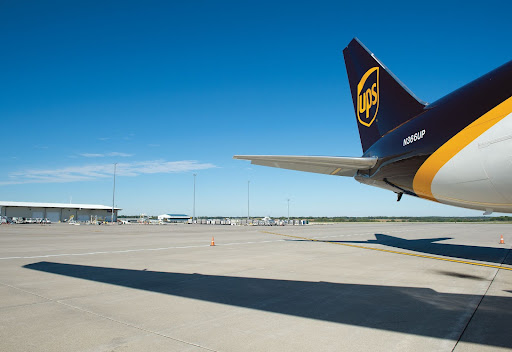Growth in air freight traffic pushes to capacity at DSM

MICHAEL CRUMB Dec 9, 2021 | 7:19 pm
5 min read time
1,094 wordsBusiness Record Insider, Manufacturing, TransportationAir freight traffic at the Des Moines International Airport has jumped 19% over the past year, and additional growth is anticipated with the arrival of Amazon Air last month, joining FedEx and UPS as air freight carriers at the airport. Here, a UPS plane is parked in the cargo area at the airport. Photo by Duane Tinkey
The Des Moines International Airport has seen a 19% increase in the amount of cargo it handled over the past year, and that was before Amazon Air began serving the airport in November.
The latest data available from the airport shows that more than 74 million pounds of cargo have passed through the airport this year as of October. That is up from just over 62 million pounds from the same period a year earlier, and is stretching the airport’s ability to handle air freight to capacity.
With Amazon Air now serving the region, the expectation is that air cargo coming through the airport will increase.
“That would be the hope, that there is significant growth opportunity if they expand their operation here,” said Kayla Kovarna, manager of communications, marketing and air service at the airport. “We are uniquely positioned with the interstate system and the rail system here, and they have great connectivity from our airport to anywhere in the state, so we feel like we are uniquely positioned and we hope there is the opportunity to grow pretty significantly from the air freight side of things.”
Air cargo activity at Des Moines was relatively flat from 2019 to 2020. Despite uncertainty heading into 2021, substantial growth in air freight has been experienced.
“We’re seeing significant increases in air cargo here at Des Moines International and we account for a little over 50% of all air cargo in the entire state of Iowa,” said Kovarna, whose conversations with Amazon began before the onset of the pandemic.
With the addition of Amazon Air came a new company to handle goods coming in and flying out on the new freight carrier.
Trego-Dugan Aviation opened its offices on Nov. 9, the same day Amazon Air began serving Des Moines, joining other freight carriers FedEx and UPS at the airport.
Vince Dugan, president and legal counsel for Trego-Dugan, said the company has about 50 employees at its Des Moines location.
The Nebraska-based company was awarded the contract to handle Amazon Air’s Des Moines operation, off-loading packages, sorting them and loading them onto trucks for delivery to other Amazon facilities. It then receives packages, sorts them and loads them onto planes to be flown to other parts of the country.
Dugan said the agreement with Amazon is the company’s first foray into air freight at the scale of the Amazon operation.
“We have done cargo for European airlines and some long-haul domestic airlines, but it was not at the scale of what we do for Amazon,” he said. “We were familiar with the process, so the newest thing for us was not unloading the aircraft but running the warehouse.”
Dugan said that while his company’s sole focus is to ensure the Amazon operation in Des Moines goes well, he’s interested in expanding Trego-Dugan’s operations in Des Moines over time.
“We like the Des Moines airport,” he said. “All the airlines that are there are customers of ours in other places, and we’re very interested in additional growth in Des Moines, although we don’t have anything in the hopper right now. Our main focus now is to solely make sure the Amazon operation just hums, and it’s doing great. The way to get the growth from our partners is just by doing a really good job, so that’s what we’re focused on.”
Trego-Dugan currently occupies half of a building just north of the airport’s parking ramp, a building shared with Signature Aviation Flight Support. The building will only be available for a couple of years and then will be demolished as part of the terminal project plan, with a new facility being built in the south cargo area, Kovarna said.
“We are continuing conversations with the Amazon Air network planning team to explore opportunities for future growth,” she said. “They are aware [the current facility] is temporary, and we will do our best to partner with them on creating opportunities here at the south cargo area. We have talked to them and shown them our development plan and land that is available to be developed. They’re not quite there yet. Obviously this service is still very new here, so they know we’ll have to start those conversations a little more robustly in the coming months.”
There is limited space for ground handlers, but the airport team was agile and was able to find space for Amazon Air, Kovarna said.
“We made it work but at some point we will hit a wall where we just won’t have any facilities left to reconfigure and utilize, so it’s crucial we not only continue moving forward with the terminal plan, but also continue establishing relationships with investors and whomever to help us develop out here on the airfield so that we can accommodate the growing cargo side of things,” she said.
Kovarna said it’s not clear when that “wall” will be hit, but the growth being seen in Des Moines is a trend nationwide.
According to Kovarna, the airport does not have the capacity to sustain long-term air cargo growth at the current rate and hopes to expand that capacity with the terminal programming plan, which includes the construction of a new terminal building, among other improvements.
But for now the airport is 100% focused on meeting passenger demand and the construction of a new terminal, she said.
“So we’re not going to take our revenues and invest them in a new cargo facility at this point,” Kovarna said. “We need to focus on the passenger terminal, so there are some facility challenges there.”
The airport isn’t privy to information from carriers about what products are being shipped by air, other than the fact that shipments have increased since the onset of the pandemic.
One example, Kovarna said, is manufacturers who might need a new part for a piece of equipment and instead of waiting for it to be delivered by truck, they pay the extra fee to have it delivered by air overnight.
“So it’s a mix of different things that could be a factor,” she said. “I can’t specifically say what is attributing to our growth here, other than UPS and FedEx have grown and the addition of Amazon has helped.”









